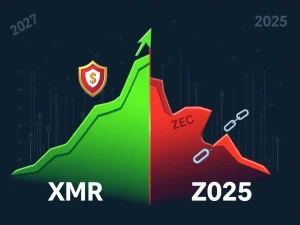Bitcoin’s Astounding Stability: How ETFs & Institutional Adoption Are Reshaping the Crypto Market

Remember the days when Bitcoin’s price would swing wildly, making headlines with dizzying highs and gut-wrenching lows? For many, that extreme Bitcoin volatility was both its allure and its biggest hurdle. But what if we told you that era might be fading, replaced by a new chapter of stability and unprecedented growth? The cryptocurrency landscape is undergoing a profound transformation, driven by powerful forces that are reshaping Bitcoin’s destiny.
Is Extreme Bitcoin Volatility a Thing of the Past?
For years, Bitcoin was synonymous with dramatic price swings, often seeing 20% daily fluctuations that thrilled day traders and terrified long-term investors. However, a significant shift is underway. According to Bloomberg analyst Eric Balchunas, the defining feature of Bitcoin’s market—its rapid price swings—may be gradually diminishing. This isn’t a sign of weakness, but rather a mark of maturation, as powerful new players enter the arena.
Since the launch of BlackRock’s IBIT, Bitcoin has seen an impressive 250% surge, yet the era of those wild, sudden price movements appears to be waning. Balchunas attributes this crucial change to the increasing influence of regulated financial products and substantial corporate investments. These large-scale, long-term investments are acting as a powerful counter-force to the speculative retail trading that once fueled much of Bitcoin’s instability. Essentially, more institutional money means less erratic behavior.
The Unstoppable Rise of Bitcoin ETFs and Accelerating Institutional Adoption
The introduction of spot Bitcoin ETFs has been a game-changer, opening the floodgates for mainstream financial institutions to access Bitcoin without directly holding the asset. BlackRock’s IBIT reaching over $100 billion in assets under management (AUM) is a monumental milestone, underscoring the massive shift in market dynamics. This isn’t just about new money; it’s about a different kind of money.
Consider a historical scenario: in the past, a large-scale sale, such as Galaxy Digital offloading 80,000 Bitcoin, would typically trigger widespread panic and a significant price drop. Yet, in the current market, this very event was absorbed without major price disruptions. What does this tell us? It signals deeper liquidity and robust institutional resilience. The market is now robust enough to handle significant sell-offs, a testament to the growing institutional adoption and the diversification of ownership beyond a few large holders.
Key Contributions of Bitcoin ETFs and Institutional Inflows:
- Increased Liquidity: Larger capital pools mean the market can absorb bigger buy and sell orders without extreme price movements.
- Reduced Speculation: Institutional investors often have longer time horizons and are less prone to emotional, short-term trading.
- Enhanced Legitimacy: The involvement of regulated entities like BlackRock and Citigroup lends credibility to Bitcoin as a legitimate financial asset.
- Broader Access: ETFs simplify access for traditional investors, bridging the gap between conventional finance and the crypto world.
What’s the Forecast for Bitcoin Price? Projections and Realities
The steady inflow into spot ETFs is not just about stability; it’s also a powerful driver for the future Bitcoin price. Citigroup, for instance, estimates that every $1 billion of ETF inflows could potentially lift Bitcoin by approximately 3.6%. Based on sustained investment from institutional players, Citigroup projects a potential price target of an astonishing $199,000 by year-end.
While such projections are exciting, they hinge on several factors, primarily the continued commitment of institutional investors. Unlike retail investors who might trade based on short-term news or emotions, institutions often execute long-term strategies, viewing Bitcoin as a strategic asset for diversification or inflation hedging. This sustained, strategic investment is crucial for reaching such ambitious price targets.
Bitcoin currently trades around $117,941, having shown impressive resilience. Its price range is already expanding beyond the $116,000–$120,000 band, reflecting growing demand. The long-term outlook remains profoundly positive, contingent on maintaining these robust inflows and navigating any potential regulatory headwinds effectively.
The Maturing Crypto Market: Beyond Speculation
Balchunas contends that this reduced volatility significantly enhances Bitcoin’s utility as a transactional asset, bringing it closer to the stability of traditional currencies. “The push from spot ETFs and corporate treasuries aims to make price moves smoother,” he noted. Fewer wild swings could genuinely attract broader adoption, allowing Bitcoin to be used more reliably for payments, corporate treasuries, and even as a reserve asset.
For some long-time traders, the shift away from extreme volatility might feel like a loss of the high-adrenaline appeal that once defined Bitcoin. The legendary “God candles”—dramatic, single-day price spikes that characterized Bitcoin’s earlier years—are indeed becoming rarer. This marks a clear transition for the entire crypto market. However, for others, this evolution represents a critical step toward legitimacy, signaling that Bitcoin is shedding its wild-west image and transforming into a viable, mature financial asset.
Potential Challenges to Consider:
- Profit-Taking by Early Holders: As the market stabilizes and prices rise, early Bitcoin holders may increasingly lock in profits, potentially leading to sell pressure.
- Shift to Derivatives: A concern raised by analysts is that as the main spot market stabilizes, some trading activity might migrate to less regulated derivatives markets, potentially introducing hidden risks and opacity.
- Regulatory Scrutiny: While institutional involvement brings clarity, it also attracts more regulatory attention, which could introduce new rules or restrictions.
A New Era for Bitcoin
Bitcoin’s journey from a niche digital experiment to a global financial asset has been nothing short of remarkable. The fading of extreme volatility, propelled by the relentless march of institutional adoption and the transformative power of spot Bitcoin ETFs, signals a new era. This maturation doesn’t just mean a smoother ride; it signifies Bitcoin’s growing utility, credibility, and its undeniable place in the future of finance. While the thrill of massive daily swings might become a relic of the past, the promise of a more stable, widely adopted, and valuable Bitcoin is an even more compelling narrative for investors worldwide.
Frequently Asked Questions (FAQs)
1. Why is Bitcoin volatility decreasing?
Bitcoin volatility is decreasing primarily due to increased institutional adoption and the introduction of spot Bitcoin ETFs. Large institutional investors tend to have long-term strategies and trade in higher volumes, which helps to absorb price fluctuations and stabilize the market compared to speculative retail trading.
2. How do Bitcoin ETFs contribute to market stability?
Bitcoin ETFs (Exchange-Traded Funds) provide a regulated and accessible way for traditional investors to gain exposure to Bitcoin. Their steady inflows create deeper liquidity, allowing the market to absorb large buy and sell orders without drastic price movements. This broadens participation beyond just crypto-native investors, adding a layer of maturity.
3. What is the role of institutional adoption in Bitcoin’s growth?
Institutional adoption brings significant capital, credibility, and long-term investment strategies to the Bitcoin market. Major players like BlackRock and Citigroup are integrating Bitcoin into their financial offerings, leading to increased demand, more robust market infrastructure, and a shift from short-term speculation to more stable, strategic holding.
4. What are the future price predictions for Bitcoin based on these trends?
Based on sustained institutional inflows, some analysts, like Citigroup, project significant price increases. For example, Citigroup estimates that every $1 billion of ETF inflows could potentially lift Bitcoin by approximately 3.6%, leading to projections as high as $199,000 by year-end, contingent on continued strong institutional demand.
5. Are there any risks associated with Bitcoin’s market maturation?
While maturation brings benefits, some risks include early Bitcoin holders taking profits, which could create selling pressure. Additionally, there’s a potential for some trading activity to shift to less regulated derivatives markets as the main spot market stabilizes, which could introduce hidden risks and reduce transparency.
6. How does reduced volatility impact Bitcoin’s utility?
Reduced volatility significantly enhances Bitcoin’s utility as a transactional asset. With fewer wild price swings, Bitcoin becomes more predictable and reliable for payments, corporate treasuries, and as a potential reserve asset. This stability makes it more attractive for broader adoption beyond just speculative investment.










